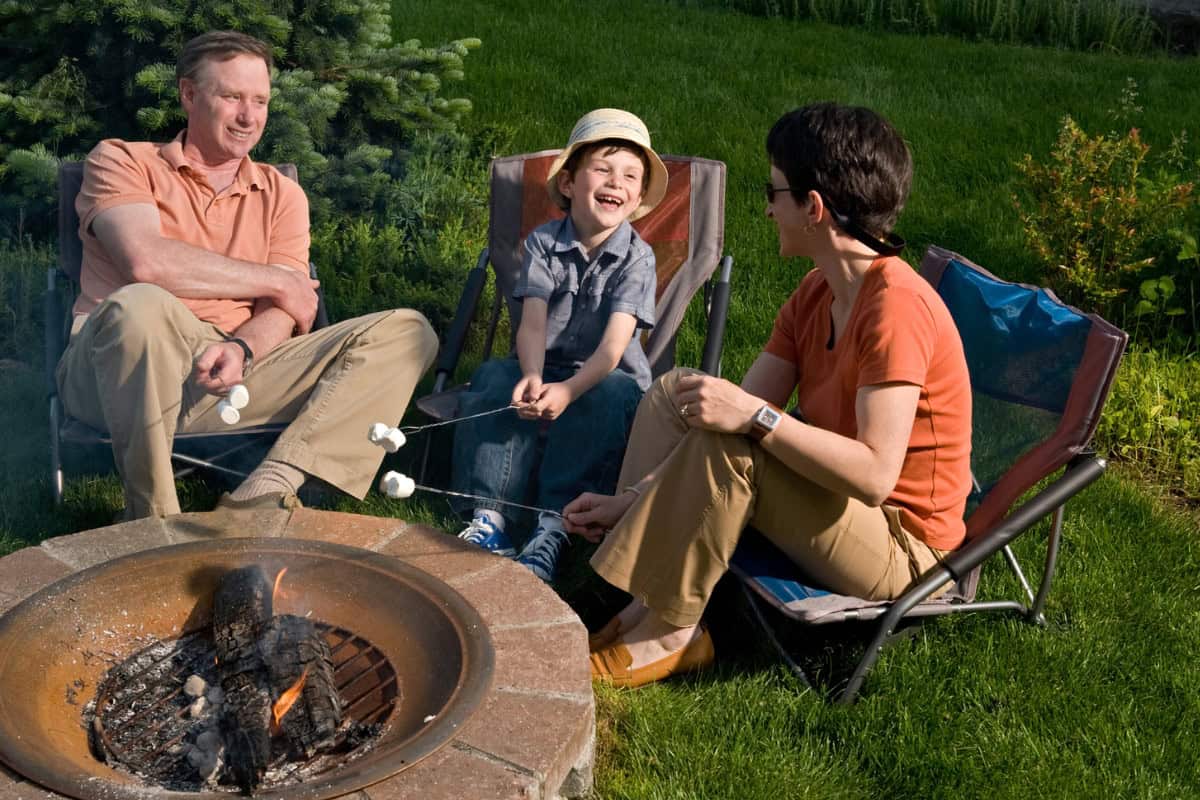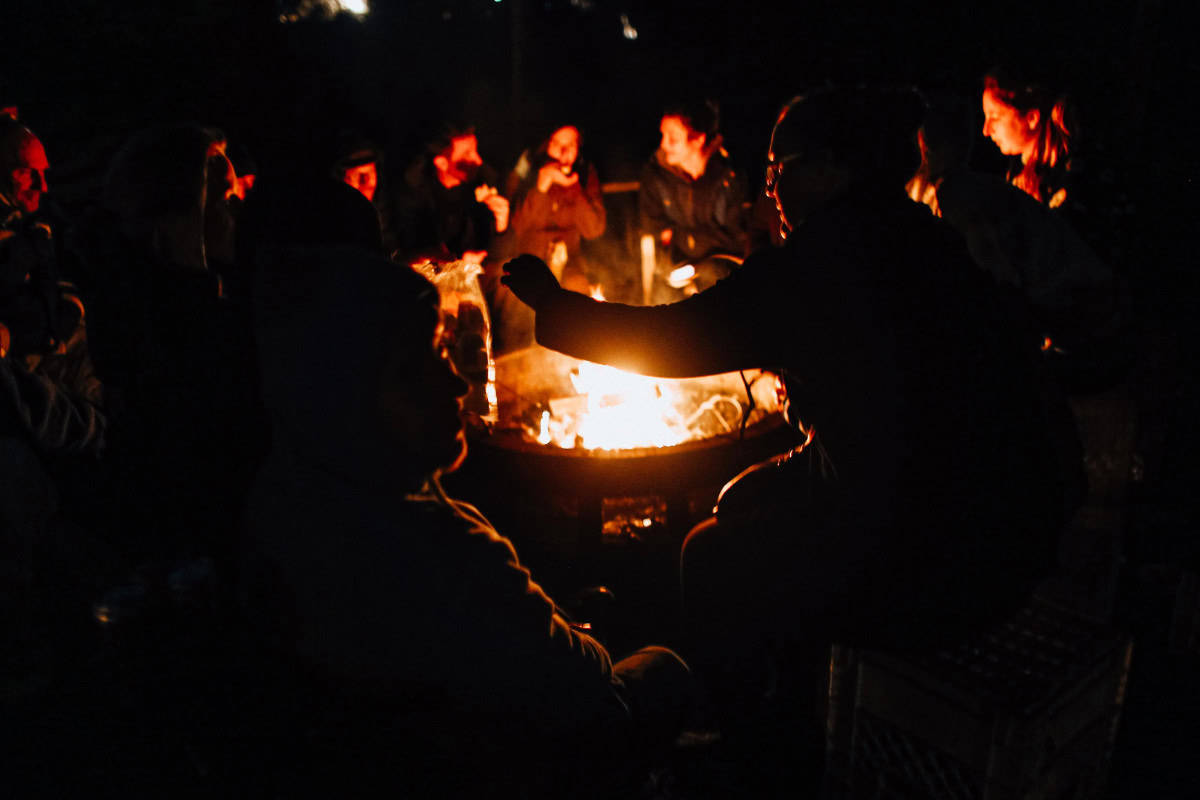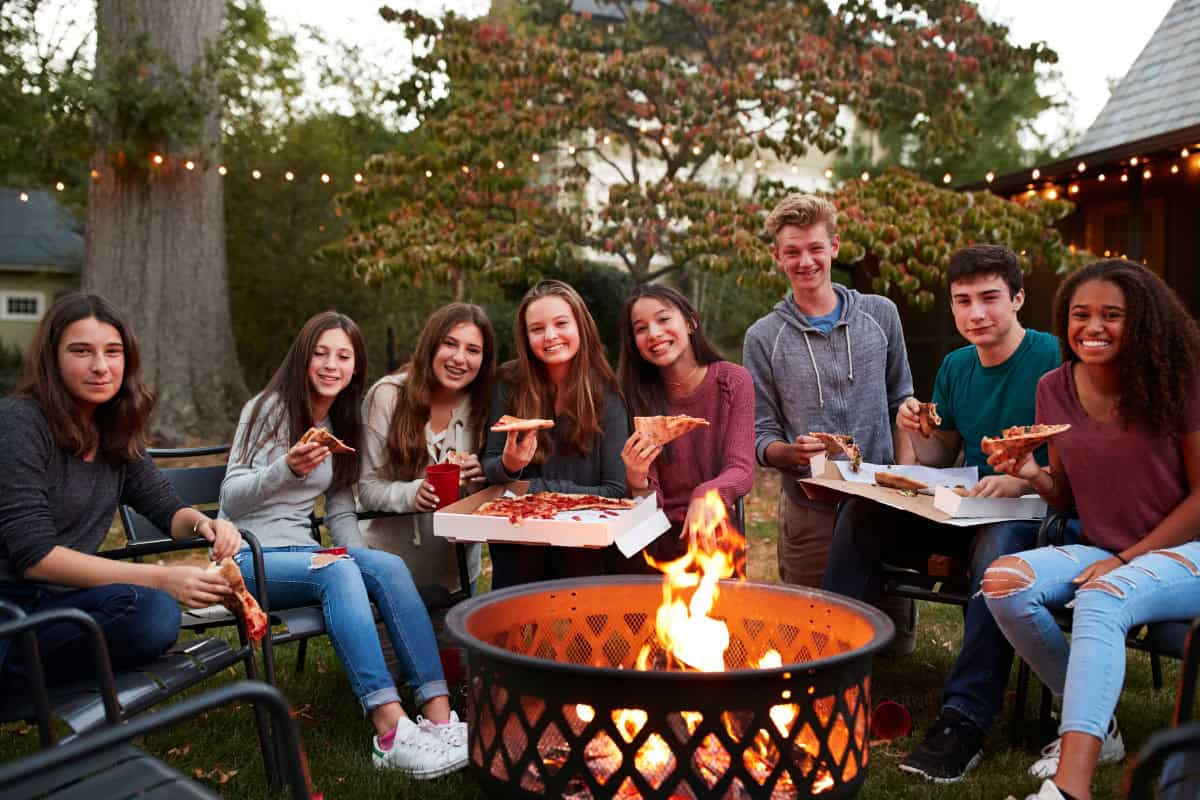
Fire pit safety for kids has become a critical concern as backyard gatherings surge in popularity.
Picture this familiar scene: your family circles around a crackling fire on a perfect evening. Kids eagerly roast marshmallows while your dog settles nearby. It’s pure backyard bliss—until curiosity takes over.
However, recent data reveals a troubling reality that most families don’t expect. Fire pit injuries have actually tripled since 2008, skyrocketing from 1,900 to over 6,200 annual cases. Even more concerning? A full 25% of these victims are children under five years old.
Here’s the part that catches parents off guard. Fire pits remain dangerous for hours after those last flames flicker out. Metal surfaces can deliver serious burns even when they appear completely harmless to the touch.
That’s exactly why we’ve created this comprehensive guide to fire pit safety for families. The fire pit safety rules for families we’ll share aren’t theoretical—they’re battle-tested protocols that busy parents can actually implement.
You’ll discover age-specific safety strategies, essential protective equipment, and proven methods that work. Most importantly, you’ll learn how to preserve those magical family moments while keeping everyone genuinely safe.
- Fire Pit Safety Statistics Every Parent Needs
- Fire Pit Safety for Kids: Understanding Hidden Hazards
- Age-Specific Fire Pit Safety Rules for Families
- Complete Pet Fire Safety Protocol: Protecting Your Four-Legged Family
- Fire Pit Safety for Kids: Essential Equipment Every Family Needs
- Fire Pit Safety Rules for Families: Your Complete Checklist
- Seasonal Fire Pit Safety Rules for Families
- Emergency Response: Fire Pit First Aid Every Family Should Know
- Expert Tips: Professional Advice for Maximum Fire Pit Safety
- Wrap-up: Building Lasting Fire Pit Safety Habits for Kids

Fire Pit Safety Statistics Every Parent Needs
The Consumer Product Safety Commission issued urgent alerts in January 2025. Alcohol-burning fire pits have caused two deaths and over 60 injuries since 2019. Additionally, the Colsen fire pit recall involved 89,500 units after 31 flame jetting incidents.
These sobering numbers underscore why fire pit safety for kids requires immediate attention from every parent. Fire pit accidents happen faster than you’d expect, often during what seem like routine moments.
Children face unique risks around fire pits. Their natural curiosity drives them to explore with their hands first. They don’t understand that metal surfaces stay hot long after flames disappear. Furthermore, their smaller bodies suffer more severe injuries from the same heat exposure.
Pet injuries are rising too. Dogs don’t recognize residual heat dangers. Their paws and fur make them especially vulnerable to burns and ember contact.
Weather conditions significantly impact fire pit safety. Wind can spread sparks up to 50 feet from the source. Dry conditions increase wildfire risks dramatically. Meanwhile, temperature changes can cause glass barriers to crack unexpectedly.
The good news? Most fire pit accidents are completely preventable. Understanding these risks helps you create effective safety protocols for your family.

Fire Pit Safety for Kids: Understanding Hidden Hazards
Fire pit dangers extend far beyond the obvious flames. Let’s break down the specific hazards that threaten children and pets.
Burns from Hot Surfaces
Metal fire pit components stay dangerous for 24 hours after use. This creates a hidden hazard that catches families off guard. Children often touch surfaces that look safe but can cause serious burns.
This makes fire pit safety for kids about more than just watching the flames—it’s about understanding residual dangers.
Toddlers face the highest risk here. They explore the world through touch and don’t understand heat warnings. Even brief contact with hot metal can cause second-degree burns on sensitive skin.
Your pets face similar dangers. Dog paw pads are tough but not heat-resistant. They can’t assess surface temperature before making contact. Long-haired breeds face additional risks from radiant heat exposure.
Spark and Ember Dangers
Wind turns harmless-looking fires into spark-throwing hazards. These glowing pieces can travel surprising distances. They ignite clothing, especially synthetic fabrics, within seconds.
Children’s loose clothing poses particular risks. Flowing sleeves or baggy shirts can catch sparks easily. Meanwhile, their natural movement around fire pits increases exposure chances.
Eye protection becomes crucial during windy conditions. Smoke and small particles irritate sensitive eyes. Children often don’t think to shield their faces from airborne debris.
Toxic Exposure Risks
Substances associated with lighting fires and fire pits can pose serious ingestion hazards. Lighter fluid (which you should never use with a fire pit, by the way, but some people will), fire starters, and related cleaning/polishing products attract curious children. Even small amounts can cause poisoning or chemical burns.
Ash presents another overlooked danger. Children and pets may investigate cooled ash piles. However, ash can contain harmful chemicals and sharp debris. Ingestion leads to stomach irritation and potential toxicity.
Smoke inhalation affects children more severely than adults. Their smaller airways become irritated faster. Children with asthma face significantly higher risks during fire pit use.
These individual hazards might seem manageable when you consider them one by one. However, when you step back and look at the bigger picture, the data tells a much more alarming story.
The fire pit safety statistics we’re seeing nationwide should give every parent serious pause. Fire pit injuries aren’t just isolated incidents happening to “other families”—they’re becoming a genuine safety crisis that’s affecting thousands of children every year.
Take a look at what the latest safety data reveals about fire pit risks for families:
The numbers don’t lie, and they’re frankly more concerning than most parents realize. That 300% increase isn’t just a statistic—it represents real children, real families, and real consequences that could have been prevented with the right safety knowledge.
Now that you understand both the specific risks and the scope of this growing problem, let’s dive into exactly how you can protect your family at every age and stage.

Age-Specific Fire Pit Safety Rules for Families
Smart fire pit safety rules for families recognize that one size doesn’t fit all when it comes to protecting children.
Different ages require different safety approaches. Here’s how to protect children at every developmental stage.
Toddlers (Ages 1-3): Maximum Protection Mode
Effective fire pit safety for kids at this age means accepting that physical barriers aren’t optional—they’re essential.
Toddlers need physical barriers between them and fire hazards. Child safety gates work well for temporary fire pit areas. Permanent installations might require custom fencing solutions.
Never leave toddlers unattended near fire pit areas. This rule applies even when fires are completely extinguished. Remember, surfaces stay hot for hours after visible flames disappear.
Start teaching the “hot” concept early. Use consistent language and demonstrate with safe examples. However, don’t rely on verbal warnings alone with this age group.
Consider crawling-level hazards during setup. Low barriers that adults step over easily become tripping hazards for toddlers. Ground-level decorative elements can hide sharp edges or heat sources.
Preschoolers (Ages 3-5): Building Fire Safety Awareness
At this stage, fire pit safety rules for families can become more interactive and educational.
Preschoolers can understand basic boundary rules. Create clear “no-go zones” around fire pit areas. Use visual markers like rope or colored tape to define safe spaces.
Introduce stop-drop-roll techniques through games and practice. Make it fun rather than scary. However, emphasize that fire safety isn’t playtime around actual fires.
Develop age-appropriate fire pit safety checklists. Simple rules work best: “Stay behind the line,” “Ask before moving closer,” “Tell grown-ups about problems immediately.”
Supervised participation helps satisfy curiosity safely. Let preschoolers help gather kindling from safe distances. They can carry water buckets or arrange seating areas too.
School-Age Kids (6-12): Gradual Responsibility Building
School-age children can learn comprehensive fire pit safety rules. They understand cause-and-effect relationships better. Additionally, they can follow multi-step safety procedures.
Introduce basic fire tool safety gradually. Show proper handling techniques for pokers and tongs. However, the most important fire pit safety rules for families always center on active adult oversight.
Teach emergency response procedures clearly. Children should know how to call for help immediately. Practice emergency scenarios regularly but keep them age-appropriate.
Use educational opportunities to reinforce safety. Explain fire science basics and safety reasoning. Understanding “why” helps children remember rules better.
Teens (13+): Advanced Safety Leadership
Teenagers can take on supervision responsibilities gradually. They can help watch younger siblings during fire pit activities. However, adult oversight remains essential for overall safety.
Teach fire pit installation safety basics. Teens can learn the right fire pit clearance requirements and setup procedures. This knowledge helps them make better safety decisions independently.
Introduce first aid basics for burn treatment. Teens should know immediate response procedures. They can also learn when situations require professional medical attention.
Emphasize legal responsibilities and consequences. Teens need to understand fire regulations and liability issues. This knowledge promotes responsible decision-making around fire safety.

Complete Pet Fire Safety Protocol: Protecting Your Four-Legged Family
Dogs and cats face unique fire pit hazards. Here’s how to keep your pets safe during backyard gatherings.
Dog-Specific Safety Considerations
Different breeds exhibit different behaviors around fires. Herding dogs may try to control family movement around fire pits. This instinct can put them dangerously close to heat sources.
Long-haired breeds need extra clearance from fire pit areas. Their fur can ignite from radiant heat before actual contact occurs. Additionally, their tails can sweep through ember zones unexpectedly.
Train dogs to recognize fire pit boundary zones. Use consistent commands and positive reinforcement. However, never rely entirely on training during active fire situations.
Leash protocols become essential during fire pit use. Even well-trained dogs can react unexpectedly to sudden noises or movements. Secure tethering keeps them safely positioned throughout activities.
Creating Pet-Safe Fire Pit Areas
Install physical barriers specifically designed for pet safety. Standard fencing might not account for digging or jumping behaviors. Consider your pets’ specific abilities when choosing barriers.
Designate comfortable retreat spaces away from fire pit heat. Provide familiar bedding and fresh water in these areas. This gives pets options when fire pit activity becomes overwhelming.
Keep hydration readily available throughout fire pit sessions. Heat exposure increases water needs significantly. Monitor pets for signs of overheating or distress regularly.
Develop pet-specific emergency response plans. Know how to quickly remove pets from danger areas. Practice these procedures regularly so responses become automatic.

Fire Pit Safety for Kids: Essential Equipment Every Family Needs
When it comes to fire pit safety for kids, equipment costs far less than dealing with preventable injuries and emotional trauma of an accident.
Must-Have Safety Equipment
Fire pit spark screens provide your first line of defense against flying embers. Choose fine mesh designs that block small particles effectively. However, ensure screens allow easy adult access for fire management.
Fire pit safety barriers create clear boundaries around heat sources. Portable options work well for temporary setups. Permanent installations offer more robust protection for regular use areas.
Fire pit heat resistant mats protect patio surfaces and provide visual safety reminders. They also catch stray sparks before they reach flammable materials. Choose mats rated for your specific fire pit temperatures. For more on this topic, check out my article —> Fire Pit on a Deck? Essential Safety Rules You Need Now.
Position fire extinguishers strategically around fire pit areas. Water extinguishers work best for wood fires. However, keep appropriate extinguisher types for any gas components too.
Fire pit safety gloves protect adults during fire management tasks. Choose heat-resistant materials that maintain dexterity. Remember, children should never handle fire pit tools, even with gloves.
Smart Safety Accessories
Digital temperature monitoring helps track surface heat levels. Some devices send smartphone alerts when temperatures exceed safe ranges. This technology provides objective safety data rather than guesswork.
Wind screens help manage ember and spark spread during breezy conditions. They also improve fire efficiency and reduce smoke production.
Emergency lighting ensures visibility during nighttime safety procedures. Solar-powered options provide reliable illumination without electrical connections. Position lights to illuminate all safety equipment locations.

Fire Pit Safety Rules for Families: Your Complete Checklist
Consistent safety procedures prevent most fire pit accidents. Use this comprehensive checklist every time.
Pre-Fire Safety Protocol
Check weather conditions before lighting any fire. Wind speeds above 10 mph create dangerous spark spread conditions. Cancel fire pit activities during high wind warnings.
Inspect the fire pit area thoroughly before each use. Remove all flammable debris within 25 feet of the fire pit. Check for dry vegetation that might ignite from stray sparks.
Verify all safety equipment locations and functionality. Ensure fire extinguishers remain fully charged and accessible. Test any electronic safety monitoring devices before starting fires.
Conduct family safety briefings before each fire pit session. Review rules and emergency procedures briefly. Assign specific adults to supervise children and pets continuously.
During Fire Safety Management
Maintain active supervision throughout fire pit activities. Assign one adult as the primary fire watcher for each session. Rotate this responsibility to prevent attention fatigue.
Follow safe fuel management procedures during fire maintenance. Add wood gradually to prevent sudden flare-ups. Never use accelerants on existing fires under any circumstances.
Monitor pet locations continuously throughout fire pit sessions. Watch for signs of overheating or distress in animals. Be prepared to move pets to cooler areas immediately.
Keep emergency response tools immediately accessible throughout activities. Don’t store safety equipment in distant locations during fire pit use. Quick response times prevent minor incidents from becoming serious injuries.
Post-Fire Safety Procedures
Extinguish fires completely using proper water application techniques. Pour water slowly to avoid steam burns. Stir ashes thoroughly to eliminate hidden hot spots.
Implement 24-hour cooling procedures before allowing unsupervised area access. Post visual warnings about continued heat dangers. Check surface temperatures with non-contact thermometers when possible.
Secure the fire pit area to protect curious children and pets. Remove any remaining combustible materials from the vicinity. Store all fire pit tools and accessories safely.
Store fire pit safety equipment properly after each use. Clean and inspect all tools for damage or wear. Replace any compromised safety equipment before the next fire pit session.

Seasonal Fire Pit Safety Rules for Families
Fire pit safety requirements change with seasons and weather conditions. Here’s how to adapt your approach.
Spring and Summer Safety Focus
Monitor wildfire risk levels throughout dry seasons. Many areas implement fire restrictions during high-risk periods. Respect all local fire bans regardless of your fire pit type.
Increase safety vigilance during peak usage months. More frequent gatherings can lead to safety complacency. Maintain strict protocols even during routine fire pit activities.
Address heat exhaustion risks from combined fire and sun exposure. Provide shade and extra hydration during hot weather fire pit sessions. Watch children and pets for overheating signs more carefully.
Consider insect control benefits versus safety priorities. While smoke deters bugs, it can also create visibility and breathing issues. Balance comfort improvements with safety requirements.
Fall and Winter Considerations
Prepare for thermal shock risks with glass fire pit barriers. Rapid temperature changes can cause glass to crack unexpectedly. Inspect glass components regularly during temperature transition periods.
Modify holiday celebration safety procedures around fire pits. Extra decorations and activities can create new hazard patterns. Adapt safety protocols to account for seasonal celebration changes.
Ensure proper fire pit ventilation during cooler weather. Temptation to position fires closer to structures increases during cold periods. Maintain safe clearance distances regardless of weather conditions.
Keep emergency access routes clear during all weather conditions. Snow, ice, or fallen leaves can obstruct safety equipment access. Maintain clear paths to all emergency response tools year-round.

Emergency Response: Fire Pit First Aid Every Family Should Know
These fire pit safety rules for families could mean the difference between a minor incident and a serious injury.
Burn Treatment Basics
Apply cool water immediately to any burn injuries. Use running water rather than ice for initial treatment. Continue cooling for 10-15 minutes to reduce tissue damage progression.
Assess burn severity carefully before deciding on further treatment. First-degree burns affect only surface skin. However, second and third-degree burns require immediate professional medical attention.
Keep basic fire pit first aid supplies easily accessible during all activities. Include burn gel, sterile gauze, and medical tape in your fire pit safety kit. However, remember that first aid supplements but doesn’t replace professional medical care.
Know when burn injuries require emergency medical consultation. Large burns, burns on faces or joints, or burns showing white or charred skin need immediate professional treatment.
Emergency Contact Planning
Teach children appropriate emergency response procedures for their age levels. Young children should know how to alert adults immediately. Older children can learn basic first aid and emergency calling procedures.
Establish clear communication protocols with neighbors during fire pit activities. Let nearby residents know about your fire pit plans. This creates additional safety resources during emergencies.
Keep emergency contact information readily available during all fire pit sessions. Include local fire department, poison control, and emergency medical services numbers. Program these numbers into easily accessible devices.

Expert Tips: Professional Advice for Maximum Fire Pit Safety
Fire safety professionals offer valuable insights for family fire pit safety. Here’s what the experts recommend.
Fire marshals emphasize proper installation and clearance requirements. They recommend 25-foot clearances from structures and 10-foot clearances from property lines. Additionally, they stress the importance of checking local fire codes before installation or placement.
Pediatric burn specialists focus on age-specific injury prevention strategies. They note that children’s thinner skin burns more quickly than adult skin. Furthermore, they emphasize that children often don’t recognize pain signals quickly enough to avoid serious injury.
Veterinarians provide comprehensive pet protection protocols. They recommend keeping fresh water available at all times during fire pit activities. Additionally, they suggest monitoring pets for signs of respiratory distress from smoke exposure.
Insurance professionals highlight coverage and liability considerations. They recommend reviewing homeowner’s policies for fire pit coverage details. Many policies have specific requirements for fire pit installations and safety equipment.

Wrap-up: Building Lasting Fire Pit Safety Habits for Kids
The fire pit safety rules for families we’ve covered aren’t suggestions—they’re proven protocols that protect what matters most.
Creating automatic safety responses takes time and consistency. Here’s how to build lasting fire pit safety habits.
Focus on habit formation rather than rule memorization. Practice safety procedures regularly until they become second nature. Consistent repetition builds muscle memory for emergency situations.
Adapt safety protocols as children grow and develop new capabilities. What works for toddlers won’t suit teenagers. Regularly review and update your family’s fire pit safety approach.
Share knowledge with other families in your community. Fire pit safety benefits from neighborhood awareness and cooperation. Consider organizing community fire safety discussions or demonstrations.
Set seasonal reminders to review and refresh fire pit safety procedures. At the beginning of each fire pit season, conduct family safety reviews. Update emergency contact information and inspect safety equipment thoroughly.
Remember, fire pit safety isn’t about eliminating fun—it’s about ensuring everyone can enjoy beautiful backyard moments for years to come. With proper preparation and consistent safety habits, your family can create wonderful memories around the fire pit while keeping everyone protected.
The most important fire pit safety rule? Never compromise on safety for convenience. Take the extra time to do things properly. Your family’s wellbeing is worth every safety precaution you implement.
For more safety related content, check out my article What is the Safest Type of Fire Pit?
Thanks for reading!


